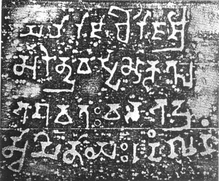Umachal rock inscription
The Umachal rock inscription is one of the earliest epigraphic sources discovered in Assam. Dated to the 5th century, the rock description was discovered in the north-eastern slopes of the Nilachal Hills (called Umachal), near Guwahati city.[1] The artifact is dated primarily on the basis of the identification of the named Surendravarman with Mahendravarman (fl. c470-494) of the Varman dynasty.[2] The script is in the eastern variety of the Gupta script and the language is Sanskrit prose.[3] Though the Nilachal Hills is known for the Kamakhya Temple, a shakta/tantra site, this temple was for Balabhadra, a god of the Vaishnavite pantheon.[4]

Another inscription, the Nagajari-Khanikargaon rock inscription, though undated, is sometimes claimed, on stylistic grounds, as the earliest.
Text
mahārājādhirāja-śrī
surendravarmmaṇā-kr̥tma
bhagavataḥ-valabhadra
svmināya-idaṁ-guhaṁ
Translation
"This cave (-temple) of the illustrious Lord Balabhadra has been constructed by Maharajadhiraja Sri Surendra Varman."[5]
See also
Notes
- The rock inscription came into view when an old banyan tree was uprooted. (Sircar 1971, p. 79) The first report on the artifact was published by R. M. Nath (Sharma 1978, p. 1)
- "...in ancient India, kings were sometimes mentioned by the synonyms of their names, Surendravarman may tentatively be identified with Mahendravarman...Surendra and Mahendra both indicate Indra." (Sircar 1971, p. 81)
- (Sharma 1978, p. 3)
- "...It is, however, more likely that Bhagavata Balabhadrasvamin of the present inscription is no other than the Vaishnavite deity variously called Balabhadra, Baladeva, Balarama, Sankarsana etc." (Sircar 1971, p. 81)
- (Sharma 1978, p. 2)
References
- Sharma, Mukunda Madhava (1978). Inscriptions of Ancient Assam. Guwahati, Assam: Gauhati University.CS1 maint: ref=harv (link)
- Sircar, D. C. (1971). Studies In The Religious Life Of Ancient And Medieval India. Delhi: Motilal Banarsidass. Retrieved 17 February 2013.CS1 maint: ref=harv (link)